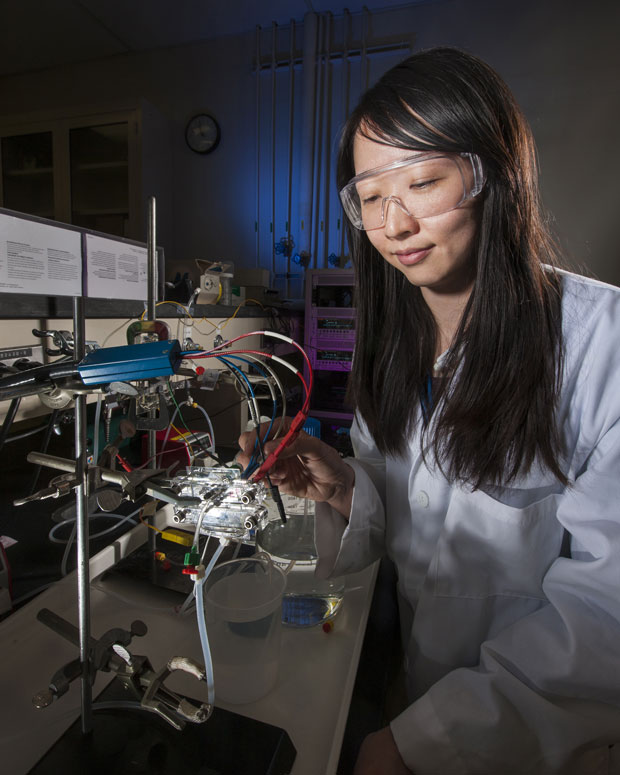Michael Stadermann (15-ERD-068)
Project Description
Potable water is a crucial national resource, necessary for basic sanitation and irrigation of crops, as well as for cooling in energy production and in many industrial processes. The ability to reduce the salt content in water allows us to reduce both withdrawal and consumption of potable water, and can provide additional sources of water, increasing the resilience of our supplies. We plan to improve the efficiency of brackish water desalination by extending the salinity range of flow-through electrode capacitive desalination (see figure), an LLNL technique with the potential to reduce brackish water desalination energy cost by a factor of 5 to 10. In capacitive desalination, salt is removed from water by charging a pair of porous electrodes immersed in water and adsorbing the ions to the charged surfaces, similar to how energy is stored in a super-capacitor. With this method, energy use scales with the amount of salt removed, and thus represents an interesting alternative for desalinating lower-salinity feed water. Currently, this technique can treat concentrations up to 5 g/L, but brackish concentrations range from 1 to 20 g/L and can show great variance. We will increase the amount of salt that can be removed in a single pass by segmenting the electrodes into multiple pairs and phasing the charging of segments, as well as timing the charging to coincide with water flow through the cell. This will enable us to selectively and locally desalinate the same volume of water several times.
The scientific challenge of the project relies on gaining a better understanding of the transport processes in the water treatment cell—electrical current has to be matched to the influx of ions to perform desalination. The regeneration process should focus released ions into the smallest volume possible to minimize brine. Dispersion and diffusion have to be accounted for to maintain the large concentration gradients between desalted and brine portions. Finally, alignment of the electric field with the flow direction of water in the flow configuration will affect ion motion. We expect to develop the first two-dimensional model for the flow-through electrode capacitive desalination process and provide experimental test data for salinities ranging from brackish to seawater. These data will establish the technique as the most effective desalination method for brackish water and hopefully show competitive results for seawater. Flow-through electrode capacitive desalination is poised to become the most energy- and cost-efficient brackish water method. Extending the range of treatable salinities up to seawater will help establish it as a superior water treatment method for brackish water.
Mission Relevance
A recent DOE report titled The Water-Energy Nexus: Challenges and Opportunities shows that water resources and their interconnectivity to energy production is attracting attention at the highest levels in DOE, especially when severe drought limits water availability and constrains the operation of power plants and other energy-production activities. Water treatment and desalination serve as a foundation for this effort, and our research is therefore relevant to the Laboratory’s strategic focus area in energy and climate security.
FY16 Accomplishments and Results
In FY16 we have (1) completed the assembly of a multi-channel test system consisting of hardware and software that will be able to perform phased charged testing on up to ten electrodes in a single device; (2) developed a model in the COMSOL multiphysics model—which handles flow, diffusion, and charging of a flow-through electrode device—and used it to capture the basic operation of a single- and a double-electrode pair cell; (3) identified several physical processes that affect the energy cost of the process, such as parasitic reactions, zero-bias adsorption because of functional groups on the electrodes, and pH effects; (4) started quantifying these effects to integrate them into the model; and (5) ran the model to be able to sweep large ranges of parameters.
This researcher is working with a flow-through electrode capacitive desalination setup. Small cells are used to study the impact of operational parameters, such as charging rate or flow rate, on the device performance and to identify energy loss mechanisms. This information will be used to determine the optimal operating conditions for larger devices.
Publications and Presentations
- Stadermann, M., “Energy breakdown in capacitive deionization.” Water Res. 104, 303 (2016). LLNL-JRNL-694923. http://dx.doi.org/10.1016/j.watres.2016.08.020
- Yatian, Q., et al., “Energy consumption analysis of constant voltage and constant current operations in capacitive deionization.” Desalination 400, 18 (2016). LLNL-JRNL-694380. http://dx.doi.org/10.1016/j.desal.2016.09.014






